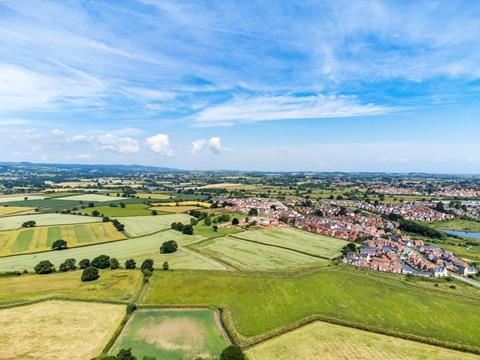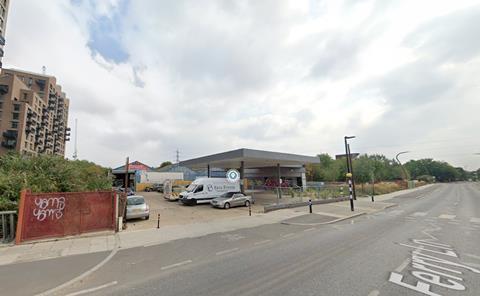Labour hopes its rebrand of ‘ugly’ green belt land will help. But will it work?

Since its general election victory at the beginning of this month, the Labour Party has made it clear that it means business when it comes to getting Britain building. New chancellor Rachel Reeves came out firing, with the reversal of the onshore wind ban and the announced just days after coming into office.
Whether Labour will be successful in achieving its ambition to deliver 1.5 million new homes over five years will come down to how effectively it can use policy to remove or circumvent the traditional obstacles to housebuilding in the UK.
One way it intends to do that is by removing the taboo around developing on the green belt, using a new term – “grey belt” – to try and shift public perceptions on the issue. Labour’s grey belt policy was announced in April, but they have yet to put meat on those bones and the term was not mentioned in the King’s Speech last week. So what might grey belt actually mean? And how useful can it realistically be to a government seeking to stimulate housebuilding?
To begin with, let’s talk about the green belt. First introduced in London in 1938, the concept was later extended to other parts of the country by the Town and Country Planning Act 1947, with the intention of preventing urban sprawl by keeping land around cities permanently open. Government statistics show that, by the end of March 2023, green belt covered around 12.6% of England’s land area, totalling 16,384 sq km.
However, many in the housebuilding sector have long held that its strict prohibitions on development have acted as a constraint on housing delivery, playing into the hands of NIMBY interests. According to the National Planning Policy Framework (NPPF), development on the green belt should be regarded as “inappropriate” and local planning authorities should only grant planning permission “in very special circumstances”.
Local planning authorities still define and maintain green belt land in their local areas, which they do by setting its boundaries as part of their local plans, and in many areas across the country, successfully policing these boundaries has become a key test for local politicians looking to get re-elected.

Even in and around major cities, public opinion tends to be supportive of maintaining green belt land. A poll by Ipsos last August found six in 10 people in England would retain the current green belt even if it restricts the country’s ability to meet housing needs, compared to nearly three in 10 who thought the opposite.
Given Labour’s landslide victory and its success in traditional Conservative heartlands in the south, its likely that many of the areas where this issue is most sensitive will now be represented on the government benches. It seems that the party is attempting to thread the needle on this issue with the help of its grey belt concept.
Its unclear who coined the phrase, but the intention is to distinguish between attractive areas of nature and ‘ugly’ built-on areas that happen to lie within the green belt. This might include former storage yards, disused quarries, car parks and caravan parks. Labour itself used the example of a run-down petrol station in Tottenham, where development of homes had been blocked because the site technically fell within green belt.
London-wide polling by Stack Data Strategy, conducted in January 2024, found that, among those who said they were opposed to more homes being developed in their own local area, 57% said they were opposed to building on ‘green belt’ land, with 20% neutral and 24% opposed. Asked instead whether they would support building on grey belt land, the answers were much more balanced. Around 36% come out in support, with 27% neutral and 38% against.
So it’s a good marketing trick, but is it good policy? That might come down to how it is actually defined, which has so far been unclear. Labour’s press release from April states that grey belt will be “a new class of land to ensure grey and poor-quality parts of the green belt are prioritised, and that any development benefits local communities”. It goes on to state that “poor-quality and ugly areas of the green belt should be clearly prioritised over nature-rich, environmentally valuable land”.
The vast majority of the green belt is undeveloped and largely used for agriculture, but around 6.8% (as of 2022) has been developed on in some way. Roughly half of this is accounted for by road and other transport infrastructure, most of which is hardly likely to be suitable for development, while the rest is comprised of residential, minerals and mining, storage, warehousing and community buildings. That’s a shade over 550 sq km of land.

Unique rules already apply to brownfield land within the green belt – sometimes referred to as PDL (previously-developed land) – which will account for a portion of that 550 sq km. Estate agents Knight Frank have identified 11,205 PDL sites across the country, with just over 40% sitting within the London green belt. Meanwhile, Merseyside and Greater Manchester green belt offered the second highest number of available sites. It estimates PDL sites could accommodate a maximum of 200,000 homes.
But it seems Labour wants to go beyond this. “At present, beyond the existing brownfield category the system doesn’t differentiate between them. This category will be distinct to brownfield with a wider definition,” its press release said.
“I think they’re looking to expand on what currently exists,” says Ian York, planning director at Lichfields. “The general feeling in the industry is that Labour needs to really define what they mean by grey belt. There isn’t a definition out there at the moment, which is slightly unhelpful and therefore you sort of don’t know how much there is, and you don’t know what supply that can bring in”.
“The general feeling in the industry is that Labour needs to really define what they mean by grey belt. There isn’t a definition out there at the moment, which is slightly unhelpful”
Ian York, planning director, Lichfields
Some made suggestions or attempted guesses at how grey belt could be defined. The current definition of PDL currently excludes agricultural or forestry buildings, as well as land used for mineral extraction – and this could be one area where Labour changes the rules. Sam Stafford, planning director at the Home Builders Federation, has suggested the following criteria for inclusion in the grey belt:
- Land that is or has been occupied by a permanent structure that is not captured by the current definition of PDL (so, for example, agricultural and forestry buildings);
- Land on the edge of urban areas that is or has been used for recreation (golf courses), but that excludes playing fields; and
- Land that has been significantly influenced or defined by the urbanising effects of development, transport infrastructure or non-agricultural human activity (pony paddocks or ‘rounding off’ a settlement inside a road or railway).
Its unclear exactly how much grey belt there would be under the HBF’s proposed definition, but property business LandTech has had a crack at its own estimate.
>>See also: A guide to the key players shaping the Labour government’s policy
Without anything resembling a grey belt dataset, it identified PDL sites using the Brownfield Land Registry and other vacant or derelict sites based on data from Ordnance Survey and HM Land Registry. It took a relatively conservative approach, only considering sites adjacent to existing roads and built up areas, ruling out the most isolated sites.
It also ruled out sites that are significantly affected by flooding, protected as sites of special scientific interest, Priority Habitat, Nature Reserves, Common Land, Ancient Woodland, Best and Most Versatile (BMV) agricultural land, or scheduled ancient monuments.
According to this methodology, there is potentially between 87 sq km and 106 sq km of quality grey or brown land within the green belt. On the assumption of 60% site coverage, to allow for some biodiversity net gain to be delivered on site, LandTech estimates that between 52 sq km and 64 sq km of this is developable. On an assumed density of 50 dwellings per hectare, it estimates a potential to deliver between 261,000 and 318,000 new homes. Remember, Knight Frank estimated that green belt PDL alone could yield only 200,000 at best.
All of this, of course, is the best guesswork of smart people with limited datasets. But it seems that grey belt could, in theory, deliver a significant, though hardly game-changing, uplift in opportunities for housebuilders. The fact that grey belt was not mentioned in Labour’s legislative plans for the year indicates that the party intends to make changes through reform of the National Planning Policy Framework (NPPF). We should know soon enough – Reeves has promised to put out a consultation document on policy changes by the end of the month.
LABOUR’S FIVE GOLDEN RULES FOR HOUSEBUILDING
1. Brownfield first
Within the green belt, any brownfield land must be prioritised for development.
2. Grey belt second
Poor-quality and ugly areas of the green belt should be clearly prioritised over nature-rich, environmentally valuable land in the green belt. At present, beyond the existing brownfield category the system doesn’t differentiate between them. This category will be distinct to brownfield with a wider definition.
3. Affordable homes
Plans must target at least 50% affordable housing delivery when land is released.
4. Boost public services and infrastructure
Plans must boost public services and local infrastructure, like more school and nursery places, new health centres and GP appointments.
5. Improve genuine green spaces
Labour rules out building on genuine nature spots and requires plans to include improvements to existing green spaces, making them accessible to the public, with new woodland, parks and playing fields. Plans should meet high environmental standards.
This would be the wisest approach, according to Lichfields’ York, who says: “Our view is that grey belt needs to be defined in the NPPF because otherwise you have to rely on the local plan system to review green belt boundaries and that could be years in the making”.
But even if Labour succeeds in adapting planning rules, bringing forward grey belt land will not be short of challenges. The ugliness of many of these former petrol stations and industrial warehouses is often more than skin deep – with pollution issues requiring costly remediation. “Even if they do open them up for development, it doesn’t mean that developers are going to be able to actually build on them,” says Anna Beadsmoore, partner in the complex property and casualty team at McGill and Partners.
This feasibility question will become even more significant if Labour wants to be serious about keeping green belt development in line with its five golden rules, which include commitments to social infrastructure and a high proportion of affordable homes.
York speculates that commercial considerations may force developers to eat into bona fide green space in order to create schemes that are remain profitable while meeting the government’s requirements.
“If you need that kind of social infrastructure alongside 50% affordable houses, then I think you are inevitably going to be directed, whether you like it or not, into looking at some larger sites as well,” he says. “It might be that the starting point is to identify areas where there is sort of poor quality and ugly areas, but then maybe considering next to those sites where you might be looking to deliver more strategic development to meet those high levels of affordable housing and deliver those services and infrastructure”.

Beadsmoore also raises concerns that the policy could create incentives for landowners to let buildings on their land go to seed in order to be able to sell it to developers. “There are concerns from a lot of property professionals and local residents around the fact that you can make anything pretty ugly and unusable,” she says. Beadsmoore also notes that historic legal agreements that often exist on green belt land could create yet another obstacle for developers.
“A lot of this land has probably got mines and minerals excepted, which means that back in the day the lord of the manor would sell off parcels of their land, but they’d say we’re still going to maintain mining rights on your land so that if there’s a coal seam found under it, we’re still allowed to mine that,” she explains.
“Now there’s not that much mining going on in the UK, but because you don’t own that, as soon as you pile into that land, you’re trespassing”. Such agreements can stop development dead in its tracks, but it is more likely to force a negotiated settlement, which could include a share of developer profit.
>>See also:
>>
>>
>>
As well as mining rights, green belt land is commonly impacted by restrictive covenants – whereby previous landowners have agreed to sell up on a particular condition. Such covenants might insist that the land be used as a single private dwelling or prohibit the development of office blocks. Beadsmoore suggests these covenants could be used by descendants to extract a negotiated settlement or, by well-informed local NIMBYs, to block developments altogether. Finally, she notes the risk of judicial review if policy is not clear enough.
We will see in time whether the grey belt concept is intended as a real driver of housebuilding, or simply a strategic beachhead for a more substantial assault on the green belt.
But whichever it is, Labour will have to do a careful job of designing its NPPF policy if it wants to make building on this land truly feasible.


























No comments yet